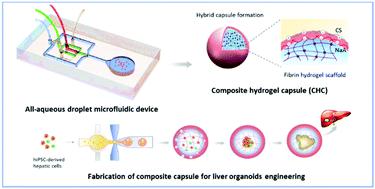当前位置:
X-MOL 学术
›
Biomater. Sci.
›
论文详情
Our official English website, www.x-mol.net, welcomes your
feedback! (Note: you will need to create a separate account there.)
One-step synthesis of composite hydrogel capsules to support liver organoid generation from hiPSCs.
Biomaterials Science ( IF 5.8 ) Pub Date : 2020-08-15 , DOI: 10.1039/d0bm01085e Yaqing Wang 1 , Haitao Liu , Min Zhang , Hui Wang , Wenwen Chen , Jianhua Qin
Biomaterials Science ( IF 5.8 ) Pub Date : 2020-08-15 , DOI: 10.1039/d0bm01085e Yaqing Wang 1 , Haitao Liu , Min Zhang , Hui Wang , Wenwen Chen , Jianhua Qin
Affiliation

|
Advances in biomaterials, especially in hydrogels, have offered great opportunities for stem cell organoid engineering with higher controllability and fidelity. Here, we propose a novel strategy for one-step synthesis of composite hydrogel capsules (CHCs) that enable engineering liver organoids from human induced pluripotent stem cells (hiPSCs) in an oil-free droplet microfluidic system. The CHCs composed of a fibrin hydrogel core and an alginate–chitosan composite shell are synthesized by an enzymatic crosslinking reaction and electrostatic complexation within stable aqueous emulsions. The proposed CHCs exhibit high uniformity with biocompatibility, stability and high-throughput properties, as well as defined compositions. Moreover, the established system enables 3D culture, differentiation and self-organized formation of liver organoids in a continuous process by encapsulating hepatocyte-like cells derived from hiPSCs. The encapsulated liver organoids consisting of hepatocyte- and cholangiocyte-like cells show favorable cell viability and growth with consistent size. Furthermore, they maintain proper liver-specific functions including urea synthesis and albumin secretion, replicating the key features of the human liver. By combining stem cell biology, defined hydrogels and the droplet microfluidic technique, the proposed system is easy-to-operate, scalable and stable to engineer stem cell organoids, which may offer a robust platform to advance organoid research and translational applications.
中文翻译:

复合水凝胶胶囊的一步合成,可支持从hiPSC生成肝脏类器官。
生物材料的发展,尤其是水凝胶,为具有更高可控性和保真度的干细胞类器官工程提供了巨大的机会。在这里,我们为复合水凝胶胶囊(CHC)的一步合成提出了一种新策略,该复合水凝胶胶囊可在无油液滴微流体系统中从人诱导的多能干细胞(hiPSC)工程化肝脏类器官。由纤维蛋白水凝胶核心和藻酸盐-壳聚糖复合壳组成的CHC是通过酶促交联反应和稳定水乳液中的静电络合反应合成的。拟议的CHC表现出高度的均一性,生物相容性,稳定性和高通量特性,以及确定的组成。而且,已建立的系统支持3D文化,通过封装源自hiPSC的肝细胞样细胞,在连续过程中分化和自发形成肝脏类器官。由类肝细胞和胆管细胞样细胞组成的封装肝类器官显示出良好的细胞活力和大小一致的生长。此外,它们维持适当的肝脏特异性功能,包括尿素合成和白蛋白分泌,复制了人类肝脏的关键特征。通过将干细胞生物学,确定的水凝胶和液滴微流体技术相结合,所提出的系统易于操作,可扩展且稳定,可以工程化干细胞类器官,这可能为推进类器官研究和翻译应用提供一个强大的平台。由类肝细胞和胆管细胞样细胞组成的封装肝类器官显示出良好的细胞活力和大小一致的生长。此外,它们维持适当的肝脏特异性功能,包括尿素合成和白蛋白分泌,复制了人类肝脏的关键特征。通过将干细胞生物学,确定的水凝胶和液滴微流体技术相结合,所提出的系统易于操作,可扩展且稳定,可以工程化干细胞类器官,这可能为推进类器官研究和翻译应用提供一个强大的平台。由类肝细胞和胆管细胞样细胞组成的封装肝类器官显示出良好的细胞活力和大小一致的生长。此外,它们维持适当的肝脏特异性功能,包括尿素合成和白蛋白分泌,复制了人类肝脏的关键特征。通过将干细胞生物学,确定的水凝胶和液滴微流体技术相结合,所提出的系统易于操作,可扩展且稳定,可以工程化干细胞类器官,这可能为推进类器官研究和翻译应用提供一个强大的平台。
更新日期:2020-09-30
中文翻译:

复合水凝胶胶囊的一步合成,可支持从hiPSC生成肝脏类器官。
生物材料的发展,尤其是水凝胶,为具有更高可控性和保真度的干细胞类器官工程提供了巨大的机会。在这里,我们为复合水凝胶胶囊(CHC)的一步合成提出了一种新策略,该复合水凝胶胶囊可在无油液滴微流体系统中从人诱导的多能干细胞(hiPSC)工程化肝脏类器官。由纤维蛋白水凝胶核心和藻酸盐-壳聚糖复合壳组成的CHC是通过酶促交联反应和稳定水乳液中的静电络合反应合成的。拟议的CHC表现出高度的均一性,生物相容性,稳定性和高通量特性,以及确定的组成。而且,已建立的系统支持3D文化,通过封装源自hiPSC的肝细胞样细胞,在连续过程中分化和自发形成肝脏类器官。由类肝细胞和胆管细胞样细胞组成的封装肝类器官显示出良好的细胞活力和大小一致的生长。此外,它们维持适当的肝脏特异性功能,包括尿素合成和白蛋白分泌,复制了人类肝脏的关键特征。通过将干细胞生物学,确定的水凝胶和液滴微流体技术相结合,所提出的系统易于操作,可扩展且稳定,可以工程化干细胞类器官,这可能为推进类器官研究和翻译应用提供一个强大的平台。由类肝细胞和胆管细胞样细胞组成的封装肝类器官显示出良好的细胞活力和大小一致的生长。此外,它们维持适当的肝脏特异性功能,包括尿素合成和白蛋白分泌,复制了人类肝脏的关键特征。通过将干细胞生物学,确定的水凝胶和液滴微流体技术相结合,所提出的系统易于操作,可扩展且稳定,可以工程化干细胞类器官,这可能为推进类器官研究和翻译应用提供一个强大的平台。由类肝细胞和胆管细胞样细胞组成的封装肝类器官显示出良好的细胞活力和大小一致的生长。此外,它们维持适当的肝脏特异性功能,包括尿素合成和白蛋白分泌,复制了人类肝脏的关键特征。通过将干细胞生物学,确定的水凝胶和液滴微流体技术相结合,所提出的系统易于操作,可扩展且稳定,可以工程化干细胞类器官,这可能为推进类器官研究和翻译应用提供一个强大的平台。











































 京公网安备 11010802027423号
京公网安备 11010802027423号